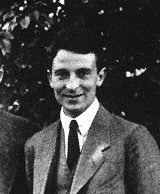Oskar Klein
| Oskar Klein | |
|---|---|

Oskar Benjamin Klein (1894–1977). Photograph taken at the Göttingen Bohr-Festspiele, June 1922.
|
|
| Born |
September 15, 1894 Mörby, Sweden |
| Died | February 7, 1977 (aged 82) , Sweden |
| Nationality | Swedish |
| Fields | Physicist |
| Institutions |
Copenhagen University of Michigan Lund University |
| Alma mater |
Nobel Institute |
| Doctoral students | David M. Dennison |
| Known for |
Kaluza–Klein theory Klein–Gordon equation Rydberg–Klein–Rees method |
| Influences | Svante Arrhenius |
| Notable awards | Max Planck Medal, 1959 |
| Signature | |
Oskar Benjamin Klein (September 15, 1894 – February 5, 1977) was a Swedish theoretical physicist.
Klein was born in Danderyd outside , son of the chief rabbi of Stockholm, Gottlieb Klein from Humenné in Slovakia and Antonie (Toni) Levy. He became a student of Svante Arrhenius at the Nobel Institute at a young age and was on the way to Jean-Baptiste Perrin in France when World War I broke out and he was drafted into the military.
From 1917, he worked a few years with Niels Bohr in the University of Copenhagen and received his doctoral degree at the University College of Stockholm (now ) in 1921. In 1923, he received a professorship at University of Michigan in Ann Arbor and moved there with his recently wedded wife, Gerda Koch from Denmark. Klein returned to Copenhagen in 1925, spent some time with Paul Ehrenfest in Leiden, then became docent at Lund University in 1926 and in 1930 accepted the offer of the professorial chair in physics at the Stockholm University College, which had previously been held by Erik Ivar Fredholm until his death in 1927. Klein was awarded the Max Planck Medal in 1959. He retired as professor emeritus in 1962.
Klein is credited for inventing the idea, part of Kaluza–Klein theory, that extra dimensions may be physically real but curled up and very small, an idea essential to string theory / M-theory.
...
Wikipedia
